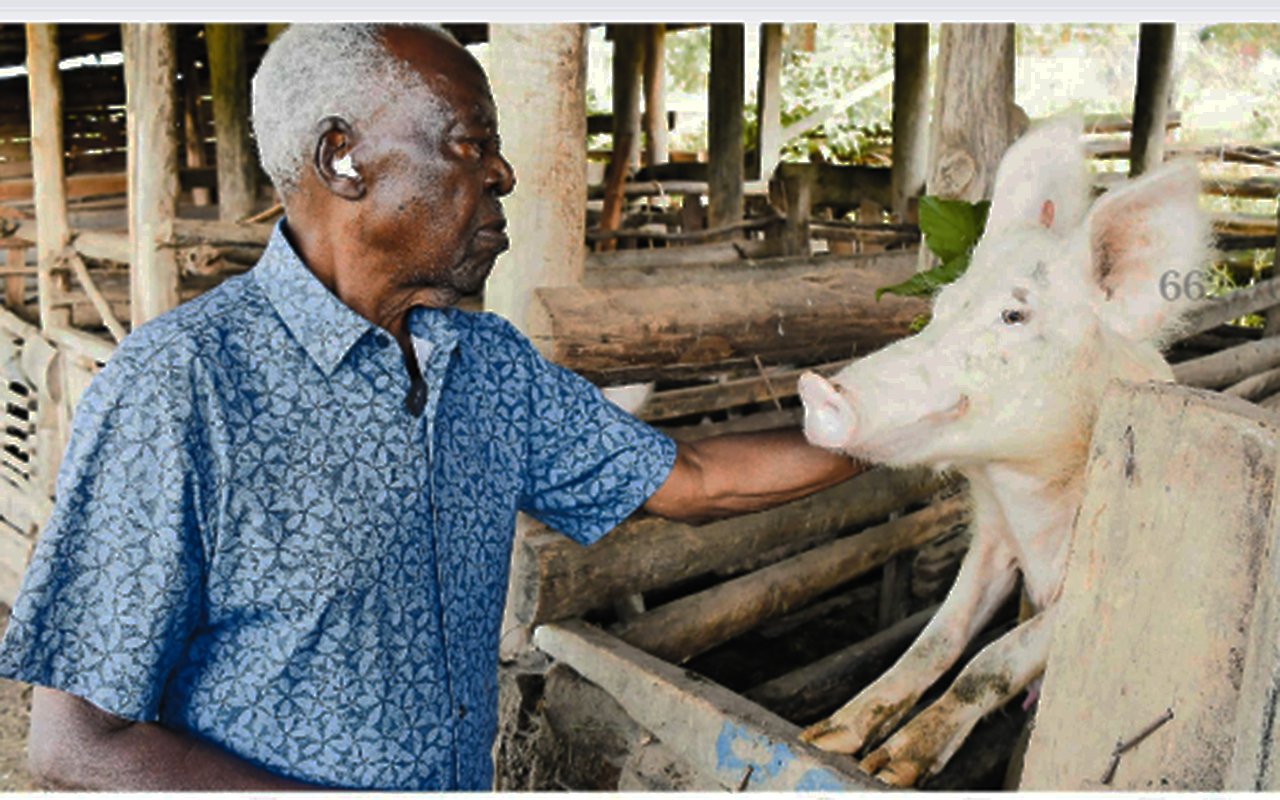How to keep your pigs healthy

It is important to inspect your animals because diseases such as African swine fever disease is a highly contagious and characterised by haemorrhages on infected animals’ skin. PHOTO/MONITOR
What you need to know:
- One essential biosecurity measure is controlling access to the farm by limiting human traffic, vehicles, and equipment coming in and out. Proper disinfection protocols should also be put in place for all visitors, staff, and vehicles entering or leaving the farm
A healthy pig will typically move around with ease and energy. If you notice slow movements and lethargy, it could signify poor health.
Pig farming can be highly profitable if proper care is given to the pigs’ health. However, it can lead to huge losses if diseases are not prevented or managed effectively.
Maintaining proper hygiene in commercial pig farms is important for preventing the diseases and ensuring the health of the animals.
In commercial pig farms, many diseases can affect the health and productivity of pigs. Some of these diseases include African swine fever, classical swine fever, swine brucellosis, pseudorabies, exudative dermatitis, coccidiosis, and respiratory diseases such as swine dysentery and mastitis.
African swine fever disease is a highly contagious viral disease characterised by hemorrhages on infected animals’ skin and internal organs. Classical swine fever is also a viral disease that causes loss of appetite, high fever, and ultimately death in pigs.
Swine brucellosis is caused by bacteria called Brucella suis which can cause reproductive tract infections leading to abortions in sows. Pseudorabies affects both wild boars and domestic pigs, causing respiratory distress, among other symptoms.
Respiratory diseases like pneumonia are common among pigs housed in crowded conditions. At the same time, mastitis occurs mostly during the lactation period for sows, which viruses, bacteria, or other pathogens can cause. Respiratory illness can lead to coughing, sneezing, fever, and decreased appetite.
Coccidiosis is another parasitic infection affecting young weanlings mainly due to unsanitary environments with poor hygiene management practices.
Therefore, farmers need to be aware of these potential threats to their livestock so they can take preventative measures against them before they spread throughout their herd.

Pig hygiene tips
Regular cleaning: Pigs should be housed in clean, well-ventilated pens that are cleaned regularly to prevent the buildup of manure and other waste.
Water supply: Clean water must always be available, as unclean water can easily transmit diseases among pigs.
Disinfection practices: Proper disinfection methods must be used when cleaning pig pens, equipment, and tools to ensure that harmful microorganisms do not continue to thrive.
Quarantine new arrivals: New pigs brought into the farm should be separated from existing herds until a qualified veterinarian has checked them.
Personal hygiene while handling pigs: Handlers must avoid spreading infections between different groups or batches of animals by keeping themselves clean, wearing protective clothing like gloves and boots, and washing their hands frequently with soap and water.
Bad health
A pig in poor health may have an unkempt appearance, dull coat, or rough hair. The animal would also appear less active than usual. Reduced appetite, increased water consumption, or the complete absence of these could mean the pig is unwell. Shortness of breath or wheezing sound while breathing might indicate respiratory problems.
A healthy pig will typically move around with ease and energy; however, if you notice slow movements and lethargy, it could signify poor health.
Gastrointestinal Issues: Diarrhea or constipation is a sign something isn’t right with the digestive system of pigs.
Health management
The health management of pigs is crucial to ensuring the profitability and sustainability of commercial pig farms. Proper management practices can reduce the incidence of diseases, which in turn minimises treatment costs and mortality rates.
One important aspect of health management is the regular observation of the pigs. Farmers should be vigilant for signs of illness such as coughing, sneezing, or diarrhea. Early detection allows for prompt intervention before a disease outbreak occurs.
Providing an appropriate diet plays a significant role in maintaining pig health. A balanced diet ensures that pigs receive all the necessary nutrients for growth and development.
Maintaining proper hygiene within the farm environment contributes significantly to pig health management. Pig pens should be kept clean and well-ventilated, while drinking water sources must always remain clean and fresh.
Farmers need to establish a working relationship with their veterinarian doctor, who will assist with managing animal health on their farm by providing expert advice on optimal vaccination protocols and potential disease outbreaks, among other aspects related to animal welfare. Good herd management practices accompanied by careful observation techniques are critical components necessary for successful pig farming operations; this includes healthy feeding habits alongside adequate animal housing facilities where farmers can provide quality care while maintaining cleanliness throughout each step in the process from birth through the slaughter period.

Overcrowding can lead to stress, which weakens the immune system of pigs and makes them more prone to disease. PHOTO/MONITOR
Best practices
The first step is ensuring that pigs have a clean, comfortable, and stress-free environment. This means regularly cleaning their pens, providing adequate ventilation and temperature control, and providing enough space for them to move around.
Another important aspect of piggery practices is feeding management. It is essential to provide pigs with a balanced diet that meets their nutritional needs while minimising the risk of disease transmission. Pigs should be fed high-quality feed in sufficient quantities at the right intervals.
Proper sanitation measures must also be implemented within the farm premises. This includes regular disinfection of equipment, floors, walls, and other surfaces where bacteria can thrive. All personnel who enter or work on the farm should follow strict biosecurity protocols, such as wearing protective clothing like boots and gloves, before entering any pig housing areas.
Pig farmers must also keep accurate records of all farm activities, including medication administration, feed consumption, and breeding data, to easily track production trends over time, which will help identify early warning signs of disease outbreaks.
Developing and maintaining good piggery practices is vital in promoting animal health by reducing stressors that compromise immunity resulting in lower incidence rates of diseases amongst pigs, thus ensuring overall profitability for commercial pig farm owners.
Prevention strategies such as providing suitable feed and water containers, isolating new animals upon arrival on the farm, and using disinfectants can greatly reduce disease incidence. Proper disposal of dead pigs is equally important.
Biosecurity measures like controlling access to the farm by visitors or other vehicles that may bring infections are crucial. Also, regular testing helps identify potential outbreaks early enough before they become widespread.
DBy providing suitable feed and water containers, isolating new animals, disposing of dead pigs properly, using disinfectants for cleaning purposes, and quarantining sick animals, one can reduce the risk of disease spread within their herd. In addition, taking care when choosing healthy pig feed that meets all nutritional requirements while maintaining health can help prevent many common diseases.
Biosecurity measures
Biosecurity is a critical aspect of managing diseases in commercial pig farms. It involves implementing measures to prevent the entry and spread of pathogens that could cause animal disease outbreaks. One essential biosecurity measure is controlling access to the farm by limiting human traffic, vehicles, and equipment coming in and out. Proper disinfection protocols should also be put in place for all visitors, staff, and vehicles entering or leaving the farm.
Another crucial step is implementing an isolation protocol for new animals introduced into the herd. This involves keeping them away from other animals until they are confirmed healthy and free from contagious diseases.
Farmers must also dispose of dead pigs properly to prevent contamination of surrounding areas. A veterinarian doctor should always supervise this process to ensure it’s done correctly without endangering animal or human health.
Pig farmers must minimise contact between their herds and wild animals that may carry harmful pathogens, such as rodents, birds, or feral swine. Additionally, proper hygiene practices like hand washing before handling pigs should be strictly enforced among employees working on the farm.
Maintaining good biosecurity measures is key to preventing disease outbreaks on commercial pig farms. Ensuring strict adherence to these measures with proper supervision from experts like veterinarians will help keep your herd healthy while protecting neighboring farms from potential infections.
Commercial farming
Managing a commercial pig farm requires careful planning and attention to detail. One important tip is ensuring the pigs have adequate space, food, water, and ventilation. Overcrowding can lead to stress, which weakens the immune system of pigs and makes them more prone to disease.
It is also important for farmers to maintain good hygiene practices in their facilities. This includes regular cleaning and disinfecting of pens or enclosures where the pigs are kept. Farmers should also consider implementing biosecurity measures, such as limiting visitors who may inadvertently bring diseases onto the farm.
Another key management tip is monitoring pig health regularly through observation and veterinary check-ups. Early detection of any illness can help prevent an outbreak from spreading throughout the herd.
Additionally, farmers must stay up-to-date with industry trends and best practices by attending conferences or workshops related to commercial pig farming. Learning about new technologies or advances in animal health research can help improve overall efficiency while reducing costs associated with disease outbreaks.
Disease prevention
Providing suitable feed and water containers is important for preventing diseases in pigs. Clean water should always be available, and feed should be stored properly to avoid contamination. It’s also important to isolate new animals before introducing them into the herd to prevent potential infections.
Proper disposal of dead pigs is another critical component of disease prevention on pig farms. Dead animals should be removed promptly and disposed of correctly to reduce the risk of bacteria growth.
Using disinfectants regularly can help remove harmful pathogens from pens, equipment, and other surfaces that may come into contact with pigs or their waste products.
Vigilant
One important aspect of health management is the regular observation of the pigs. Farmers should be vigilant for signs of illness such as coughing, sneezing, or diarrhoea. Early detection allows for prompt intervention before a disease outbreak occurs.
Control
One essential biosecurity measure is controlling access to the farm by limiting human traffic, vehicles, and equipment coming in and out. Proper disinfection protocols should also be put in place for all visitors, staff, and vehicles entering or leaving the farm
Adopted from Agrifarming




